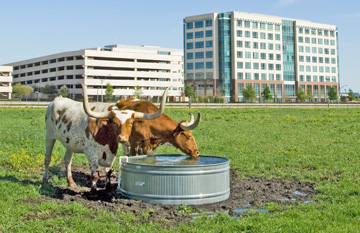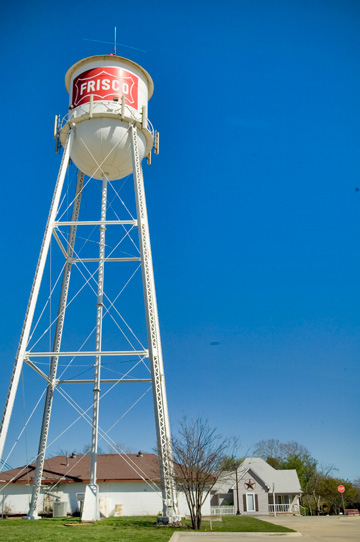I first admired Frisco on paper, from the effete confines of Washington, D.C., where I work as a reporter and professional pop-culture snarkist. I was trolling census figures and other data to find a boomtown to temporarily move to, so I could write a book about families living in a modern exurb. I sought the exact right everyplace from the demographics: new home sales, a tremendous growth rate, high income levels, boggling increases in sales tax revenues, and so on. I considered suburbs outside Atlanta and Columbus, but they just didn’t feel right. On a trip to Dallas, a couple of people insisted I take a look at Frisco. (“It’s Plano’s Plano,” one of them explained.) I drove all the way up Preston Road and immediately fell in the strangest sort of love.
That was three years ago. The book is done and will be published later this year, and I’m back in Washington for good. Yet I still find myself sitting at my desk, 1,300 miles away, wishing I could waste one more afternoon at Stonebriar Centre—or the rest of Frisco’s 7 million square feet of chain retail and dining. I’m a weirdo about Frisco. To me it is the fullest expression of who we became in the 21st century, for good and bad, and what Americans most deeply value, counter to every aesthetic and environmental criticism of such places. People just want to be safe and happy, and to buy nice, new things. You’ll find plenty of real life in a mall.
Yes, I can hear you snorting. My only problem with Frisco is that it’s too easy for everyone else to make fun of. It’s too easy to get there and see only the endless vista of affordable faux-luxury, to notice only the banality and rigid sameness, to hear only the Hitchcockian dread of thousands of grackles in the strip mall trees. Tales of suburban dystopia and ennui are as old as Revolutionary Road. Can there be some other story here? I came to Frisco believing there was. Among the first words I wrote in my notebook were these: surrender to it.
Not long after moving there (in the preheated oven of summer 2006), I took a drive with George Purefoy, the city manager since 1987, who had overseen Frisco’s growth from a town of about 6,000 to a city that was then nearing 100,000. (About 800 people were moving there every month; that growth rate has since decreased by more than half, according to estimates.) Purefoy talked about the history of each shopping center, sporting facility, school, municipal building, and empty grain silo as it passed by. The new City Hall had been named in his honor, which embarrassed him, since he has neither retired nor died and is only in his 50s.

As we looped around Stonebriar Centre in Purefoy’s pickup, the sky blushed with an alluring pink dusk, and he acknowledged that all the retail options in the world wouldn’t be able to give his city a true identity. For all the efforts to construct a civic life—new parks, a heritage museum, a sense of what came before (roving Indians, the Shawnee Trail, and, in 1902, the St. Louis & San Francisco Railroad depot—hence the name “Frisco”), the rest of this story was going to depend on the newcomer exurbanites themselves, many of whom showed little interest in much besides their children and property values.
It’s hard to read Frisco, when any connection you first make there usually occurs in the course of a retail transaction. But you get over it. In Frisco I could imagine some alternate life I might have had: a wife, a family, a media room, extra closets, extra faith. I got to pretend a little and shop a lot.
I have (or had) a favorite waiter at Frisco’s Applebee’s and a favorite Chinese shiatsu chair masseuse by the Dick’s Sporting Goods in Stonebriar Centre. I know bartenders at the Cheesecake Factory, and I worked out one morning with the moms (and babies) in the mall’s StrollerFit club. I wave hello to the sculptures of cattle and cowboys in its parking lots. The bars still close at midnight on weekdays, but no matter, for whenever I’m back in town I get high on the kindness of cash register ladies, or the lovely drawls of Sonic girls who bring giant diet cherry limeades to my car. At Stonebriar Country Club and the megachurches, I am eternally cheered by all the bleachy-white veneer smiles, the buttery tans, the golden highlights in the hair—and not just on the men.
That’s a Frisco joke (a Phrisceaux joke), at once acknowledging that Frisco is full of itself and empty at the same time, and that everyone who lives there knows a thing or two about the emptiness. “You’re not doing a Friday Night Lights on us, are you?” a city employee once chided me after a council meeting. People in Frisco doth protest too much on the subject of not caring what others think of them; of course they care. Those who moved here in the last decade had to put up with all sorts of hell from their Dallas friends, who almost never come to visit but occasionally come to shop.

But that’s paper. To actually be in Frisco is to feel like everything’s going to be fine. It still grows. I am seldom happier than when I fly into DFW, rent a car, and trek up the toll roads with Jack FM blaring homogeneous hits, arriving in the ever-optimistic ’burb I came to adore. Every trip back, another execu-hotel for movers and shakers has opened near Stonebriar Centre. I check in to whichever one is the newest and sleep deeply, dreaming along with Frisco.
Washington Post writer Hank Stuever’s book Tinsel: A Search for America’s Christmas Present, which follows three families through three consecutive Christmases in Frisco, will be released this fall.






